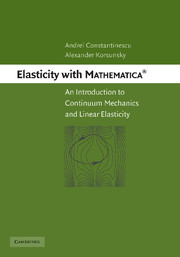Book contents
- Frontmatter
- Contents
- Acknowledgments
- Introduction
- 1 Kinematics: displacements and strains
- 2 Dynamics and statics: stresses and equilibrium
- 3 Linear elasticity
- 4 General principles in problems of elasticity
- 5 Stress functions
- 6 Displacement potentials
- 7 Energy principles and variational formulations
- Appendix 1 Differential operators
- Appendix 2 MATHEMATICA® tricks
- Appendix 3 Plotting parametric meshes
- Bibliography
- Index
1 - Kinematics: displacements and strains
Published online by Cambridge University Press: 11 November 2009
- Frontmatter
- Contents
- Acknowledgments
- Introduction
- 1 Kinematics: displacements and strains
- 2 Dynamics and statics: stresses and equilibrium
- 3 Linear elasticity
- 4 General principles in problems of elasticity
- 5 Stress functions
- 6 Displacement potentials
- 7 Energy principles and variational formulations
- Appendix 1 Differential operators
- Appendix 2 MATHEMATICA® tricks
- Appendix 3 Plotting parametric meshes
- Bibliography
- Index
Summary
OUTLINE
This chapter is devoted to the introduction of the fundamental concepts used to describe continuum deformation. This is probably most naturally done using examples from fluid dynamics, by considering the description of particle motion either with reference to the initial particle positions, or with reference to the current (actual) configuration. The relationship between the two approaches is illustrated using examples, and further illustrations are provided in the exercises at the end of the chapter. Some methods of flow visualisation (streamlines and streaklines) are described and are illustrated using simple examples. The concepts are then clarified further using the example of inviscid potential flow.
Placing the focus on the description of deformation, the fundamental concept of deformation gradient is introduced. The polar decomposition theorem is used to separate deformation into rotation and stretch using appropriate tensor forms, with particular attention being devoted to the analysis of the stretch tensor and the principal stretches, using pure shear as an illustrative example. Trigonometric representation of stretch and rotation is discussed briefly.
Discussion is further specialised to the consideration of small strains. Analysis of integrability of strain fields then leads to the identification of the invariant form of compatibility conditions. This subject is important for many applications within elastic theory and is therefore dwelt on in some detail.
- Type
- Chapter
- Information
- Elasticity with Mathematica ®An Introduction to Continuum Mechanics and Linear Elasticity, pp. 8 - 40Publisher: Cambridge University PressPrint publication year: 2007



